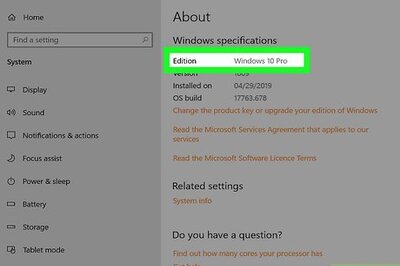
views
The Indian stock market witnessed its worst week since June 2022 declining 4.5 per cent between September 30 and October 4 amid unfavourable global factors. The sharp fall has made the Indian markets relatively cheaper as compared to the previous week. As a result of this, investors might be attracted to start a mutual fund systematic investment plan (SIP) amid falling markets. Here’s the current stock market condition and its outlook you need to know.
The Current Indian Market Situation
The Indian stock market experienced a sharp downturn this week, breaking its three-week winning streak. The NSE Nifty and BSE Sensex both plummeted nearly 4.50 per cent, closing the week at 25,014.60 and 81,688.45, respectively. The 4,100 points fall led to a loss of Rs 16 lakh crore for investors within a week.
Real estate and financial services stocks were hit the hardest.
The Nifty closed at a 3-week low, managing to stay just above 25,000. Selling pressure was widespread, and the overall market breadth favoured declines.
India VIX, or the India Volatility Index, is a market that measures the market’s expectation of volatility in the Nifty 50 index rose by (+18.10 per cent) and closed the week at 14.12.
Why Are Markets Falling?
Pravesh Gour, senior technical analyst at Swastika Investmart, said, “Foreign portfolio investors (FPIs) are shifting funds away from India, viewing it as a relatively expensive market. Instead, they are turning to China, anticipating an economic revival there.”
During the week ended October 4, foreign portfolio investors (FPIs) were the most significant sellers withdrawing nearly Rs 37,088 crore from Indian markets.
“The recent optimism in China has been fuelled by the People’s Bank of China (PBOC) cutting interest rates and lowering the reserve requirement ratio, alongside fiscal stimulus measures. These moves triggered a strong rally in both Chinese and Hong Kong markets, pushing up commodity prices,” Gour added.
Palka Arora Chopra, director of Master Capital Services, said, “This significant decline has been attributed to a combination of fundamental challenges, which prompted short-term profit-taking. The primary driver behind the selloff was the diversion of foreign funds to China after the country’s central bank introduced substantial monetary stimulus.”
Recently, China’s central bank announced its largest-ever ‘stimulus package’ on mortgages worth $5.3 trillion (about Rs 44.27 lakh crore). Adding to it, the downpayments on the existing loans have als been decreased, apart from reducing the reserve requirement ratio (RRR) by 50 basis points and lowering its 14-day repo rate by 10 basis points.
“This move has fuelled expectations of further monetary measures to support China’s weakening economy,” Arora added.
Escalating geopolitical tensions in the Middle East, particularly after Iran launched nearly 180 ballistic missiles at Israel, further dampened market sentiment.
“Investors are now bracing for a possible retaliatory strike by Israel, potentially targeting Iran’s nuclear facilities or major oil fields,” she said.
A more than 11 per cent surge in oil prices this week has reignited inflationary concerns, which could undermine the growing optimism surrounding global interest rate cuts. The Brent crude oil touched $78 per barrel on Friday, compared with nearly $70 in the previous week.
India’s Latest Macroeconomic Indicators
In the month of September, India’s manufacturing activities slowed to an eight month low, with the HSBC India Manufacturing PMI falling to 56.5 from 57.5 in August. Fiscal deficit for April-August stood at Rs 4.35 lakh crore, or 27 per cent of the annual target and government expenditure during the period was Rs 16.52 lakh crore, slightly lower than last year’s Rs 16.72 lakh crore due to reduced spending ahead of general elections.
India’s foreign exchange reserves climbed for the seventh consecutive week to a record high of $704.89 billion as compared to $692.30 billion previous week. Foreign institutional investors (FIIs) sold equities worth Rs 40,511 crore, while Domestic Institutional Investors (DII) bought equities worth Rs 33,075 crore.
Market Outlook
“On the domestic front, the market’s focus will also be on the Reserve Bank of India’s (RBI) Monetary Policy Committee (MPC), which is scheduled to meet from October 7 to 9, 2024, with the outcome to be announced on Wednesday, October 9,” said Pravesh Gour, senior technical analyst at Swastika Investmart.
The RBI is expected to keep the benchmark repo rate unchanged in its upcoming policy review, having maintained it at 6.5% for the ninth consecutive meeting in August 2024. This aligns with market expectations, as the central bank aims to bring inflation closer to its medium-term target of 4% while supporting economic growth.
The Q2 earnings season is also kicking off with key companies like TCS, Tata Elxsi, DMart, and IREDA among others, which will drive stock-specific movements, he added.
Additionally, commodity prices, the US dollar index, and key U.S. macroeconomic data will play a crucial role in determining market direction. Geopolitical developments will also continue to be a significant factor on the global front.
“The outlook for the market will also be guided by India;s industrial production (YoY) (August), India’s Manufacturing Output (MoM) (Aug), US FOMC Meeting Minutes, US Core CPI (MoM) (Sep), US CPI (MoM) (Sep), US Initial Jobless Claims, US PPI (MoM) (Sep) and UK GDP data,” Master Capital’s Arora said.
Technical View
“Technically, the Nifty has the immediate and critical support level stands at 24,750, with the next support around the rising 100-day moving average (DMA) near the 24,400 mark. On the upside, 25,500 and 25,700 will act as key resistance levels during any potential pullback,” Pravesh Gour said.
At Bank Nifty, the 100-day moving average (DMA) at 51,100 serves as an immediate support level, with the 50,000-49,500 range, which aligns with the 200-DMA, acting as the next support zone. On the upside, 52,500 and 53,300 will be key resistance levels during any pullback, he added.


















Comments
0 comment